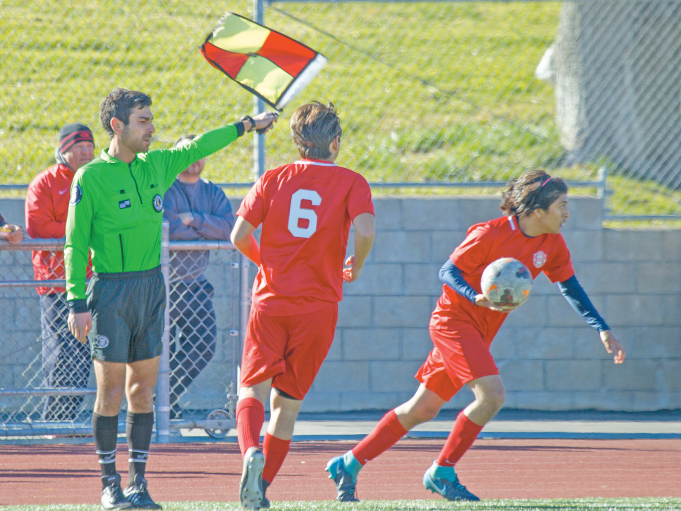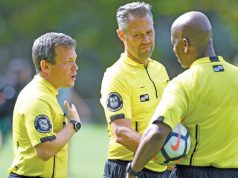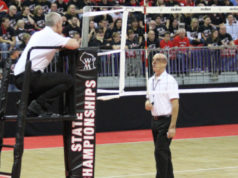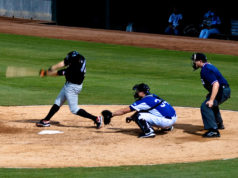T
he throw-in, a common restart at all levels of soccer, presents a number of challenges to the officiating team — some of which must be dealt with during the pregame while others demand a quick application of the appropriate rule 15 (NFHS and NCAA) or Law 15 (IFAB).
One of an assistant referee’s (AR) important responsibilities is indicating the direction, and sometimes location, of a throw-in. During the pregame, the referee should review with both ARs how and when to signal the direction of a throw-in and how and when to indicate an illegal throw-in. Usually, a referee will want the AR to signal an illegal throw-in; however, some referees prefer to call the improper throw-in if it occurs within their quadrants. In most cases, especially with a team that prefers quick restarts, the AR or the referee is expected to make a quick decision on the direction of the throw-in. The AR and referee can agree in the pregame on an advance “soft signal” such as a hand or finger at the waist pointing one way, or a discreet nod of the head, to indicate the direction of the throw-in. This approach prevents conflicting and simultaneous signals being given from the referee and the AR.
A standard practice is for the AR to signal the direction of the throw-in in his/her half of the field and for the referee to follow with a signal in the same direction. In the referee’s half of the field, the referee will be the first to signal the direction and the AR will follow with a flag to support the decision. Having one of the officials signal first, followed by a duplicate signal from the other, or using soft signals, prevents conflicting signals and allows the players to have confidence in the officiating crew. Using headsets, if they are available, is another way to exchange information when signaling which team shall be awarded the throw-in.
Many referees “let” the players dictate the throw-in’s direction by pausing briefly when the ball goes into touch to see how the players react. If the players on the one team, for example, begin to drop back to a defensive alignment, it usually is an acknowledgment that one of their players last touched the ball and that the throw-in should be taken by their opponents. The referee should be aware that this could be a coached strategy, however. Coaches who know that referees watch and react to the players on a throw-in might tell their players to go after a closely contested ball automatically, even though they know their team touched it last. If both teams contest the throw-in, the AR or the referee, depending on the location of the throw-in, must make an immediate decision.
Referee positioning on a throw-in is important and will vary depending on where the throw-in is being taken. Ideally, the referee should be relatively close to the thrower when the throw-in is in the referee’s quadrant. Some referees prefer to position themselves perpendicular to the spot on the touchline where the throw-in must be taken. This can lessen, or prevent, a common practice for the player taking the throw-in to run up the line for several yards before completing the restart. Calling the thrower back to line up with the referee usually sends a message as to where the throw-in must be taken.
For an offensive throw-in, the referee wants to watch the thrower and the downfield area where the ball most likely will be thrown. The referee needs to keep an eye on any jostling or physical contact between players prior to and during the throw-in. Encroachment from the defending team also needs to be monitored; a defending player must be at least two yards from the thrower and cannot impede or interfere with the attempted throw-in. In addition, the referee must watch the thrower’s hands. Both must be on the ball and the throw must be taken from behind the head and in one continuous motion; if the two requirements are met, putting a “spin” on the throw-in is legal. The AR also must watch the thrower to make sure that both feet are on or behind the touchline. A somersault throw-in is legal, as long as the player making the throw-in is facing the field and completes the throw-in with both feet on or behind the touchline.
For a defensive throw-in in the referee’s quadrant, the referee wants to watch the thrower and trailing players, as well as the area where the ball most likely will be thrown, to monitor the interaction among the opponents. The AR must watch the thrower and the players in front of him or her for possible infractions. A common throw-in practice in the waning moments of a game is for a player from the winning team to pick the ball up and then decide to leave it for another player. To guard against repeated tactics, the referee can make a judgment call to issue a verbal warning, stop the clock, or to caution the offending player for delaying the restart. Just because the throw-in is a common restart doesn’t diminish the officiating crew’s responsibility to pay close attention to the rules and laws of the game and to communicate with each other at every opportunity.
What's Your Call? Leave a Comment:
Note: This article is archival in nature. Rules, interpretations, mechanics, philosophies and other information may or may not be correct for the current year.
This article is the copyright of ©Referee Enterprises, Inc., and may not be republished in whole or in part online, in print or in any capacity without expressed written permission from Referee. The article is made available for educational use by individuals.

















